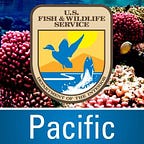Oahu Tree Snails-The Voice of the Forest
Hawai‘i was once home to over 750 species of terrestrial snails — one of the most stunning examples of species radiations in the world. But over the years, these unique Hawai‘i species have been declining due to invasive predators, habitat destruction, and over collection.
The entire genus Achatinella — which consists of 41 species of small, colorful tree snails — is endemic to O‘ahu. Of those, 30 species are believed to be extinct and 11 are near extinction.
In Hawaiian culture and oral history, the snails, kāhuli or pūpū kani oe, are known as the voices of the forest and are described as singing as they travel up and down the trees. Though their voices may have grown dim, we are still working to keep their song alive.
Habitat and Range
Currently, O‘ahu tree snails are restricted to remnant native forests on the highest ridges of the Ko‘olau and Wai‘anae ranges on the island of O‘ahu.
Historically, the genus was widely distributed from near sea level along the windward coast to the central plains and throughout the Ko‘olau and Wai‘anae mountains.
Diet and life cycle
O‘ahu tree snails are nocturnal and graze on a fungus that grows on the leaves of native plants. During the day they seal them selves up against leaves or tree trunks.
Although native snails are sometimes found on non-native plants it is not known if the fungus on these introduced species is sufficient to support healthy populations.
Adult snails are hermaphroditic and long-lived. Their life span is thought be at least 11 years, although growth rates and reproductive rates are very low.
The snails give birth to live young, and can reproduce anywhere from 4 to seven times a year.
Threats to the species
In the recent past, the introduction of rat species, over-collection, and the introduction of the carnivorous snail Euglandina rosea have resulted in declines in the genus.
Current threats include the continued degradation of habitat by non-native, invasive vegetation, especially strawberry guava (Psidium cattleianum), Christmas berry (Schinus terebinthifolius), silk oak (Grevillea banksii), shrub verbena (Lantana camara), and Koster’s curse (Clidemia hirta).
Pigs (Sus scrofa) also degrade habitat and predation by rats and introduced snails continues to be a problem. Low reproductive rates and limited dispersal abilities increase the vulnerability of this genus.
Reason for hope
Inside two unassuming trailers off the Pali Highway on the island of O‘ahu, scientists with Hawaiʻi’s Department of Land and Natural Resources are fighting to save the O‘ahu tree snails. The trailers are home to the Hawaiʻi Invertebrate Program run by Cynthia King and the Snail Extinction Prevention Program run by David Sischo.
The programs, which are partly funded by the U. S. Fish and Wildlife Service not only work to protect current populations and key breeding habitats, but also to establish additional populations, thereby reducing the risk of extinction.
Prior to the creation of SEPP, the majority of efforts focused on monitoring the decline of species; since the creation of SEPP, they have begun to halt species loss and actually improve the status of the snails.
Conserving and recovering Hawaiʻi’s native and endangered species requires partnerships and dedication. Together with the state of Hawai‘i, the U. S. Fish and Wildlife Service is helping to ensure that the voices of the forest continue to sing in Hawaiʻi.
The U.S. Fish and Wildlife Service works with others to conserve, protect, and enhance fish, wildlife, plants, and their habitats for the continuing benefit of the American people. For more information, connect with us through any of these social media channels at https://www.facebook.com/PacificIslandsFWS, www.flickr.com/photos/usfwspacific/, or www.twitter.com/USFWSPacific.
